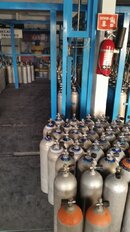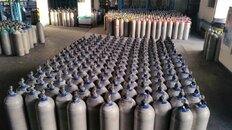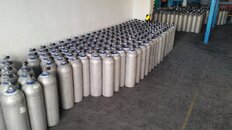You are using an out of date browser. It may not display this or other websites correctly.
You should upgrade or use an alternative browser.
You should upgrade or use an alternative browser.
Reminder to check your tanks for CO !
- Thread starter cruiser
- Start date
Please register or login
Welcome to ScubaBoard, the world's largest scuba diving community. Registration is not required to read the forums, but we encourage you to join. Joining has its benefits and enables you to participate in the discussions.
Benefits of registering include
- Ability to post and comment on topics and discussions.
- A Free photo gallery to share your dive photos with the world.
- You can make this box go away
Hatul
Contributor
Interesting. I stayed at Blue Angel in Nov 2015 and brought my Analox CO detector and also was getting positives especially in Nitrox. My experience was the air was lowest, then EAN32 and the worst was EAN36. One tank read 10 ppm and was returned to the filling facility. At first they were a bit skeptical but they did say they would check with the filler. Most of the week I used air and EAN32 and avoided 36 and even then I picked the tanks with lowest reading.
Then one day I was sitting around and heard that one of the divemasters surfaced early because the tank gas had a bad taste and he did not feel well. I asked him what he was using and sure enough it was EAN36. That tank was also sent for analysis.
They definitely did have a CO problem with their Nitrox in particular. To their credit on the last day I was there, the problem was mysteriously solved and I no longer detected CO with my tester.
I recommend everyone test their tank gas for CO in Cozumel before diving.
Then one day I was sitting around and heard that one of the divemasters surfaced early because the tank gas had a bad taste and he did not feel well. I asked him what he was using and sure enough it was EAN36. That tank was also sent for analysis.
They definitely did have a CO problem with their Nitrox in particular. To their credit on the last day I was there, the problem was mysteriously solved and I no longer detected CO with my tester.
I recommend everyone test their tank gas for CO in Cozumel before diving.
Hatul
Contributor
Bamafan, those are nice photos of Meridiano, but it says nothing about what's going into those tanks.
DandyDon, 10ppm seem very high. This may be a limit for gas breathed at 1 atm, but not for scuba. It's the partial pressure of CO that matters and that increases linearly with depth, so at 99 feet (4 atm) it's 4 times that at sea level, and would be like breathing 40 ppm on surface.
DandyDon, 10ppm seem very high. This may be a limit for gas breathed at 1 atm, but not for scuba. It's the partial pressure of CO that matters and that increases linearly with depth, so at 99 feet (4 atm) it's 4 times that at sea level, and would be like breathing 40 ppm on surface.
Bamafan, those are nice photos of Meridiano, but it says nothing about what's going into those tanks.
DandyDon, 10ppm seem very high. This may be a limit for gas breathed at 1 atm, but not for scuba. It's the partial pressure of CO that matters and that increases linearly with depth, so at 99 feet (4 atm) it's 4 times that at sea level, and would be like breathing 40 ppm on surface.
Never mind if you are going to 60m (7 atm)
- Messages
- 54,470
- Reaction score
- 8,575
- # of dives
- 500 - 999
Well, it's certainly more complicated than that. Wikipedia seems to have greatly expanded their article on Carbon Monoxide, but "In the United States, the OSHA limits long-term workplace exposure levels above 50 ppm."DandyDon, 10ppm seem very high. This may be a limit for gas breathed at 1 atm, but not for scuba. It's the partial pressure of CO that matters and that increases linearly with depth, so at 99 feet (4 atm) it's 4 times that at sea level, and would be like breathing 40 ppm on surface.
Short term, you can do okay with much higher rates at the surface as it is a level plus time exposure risk as the CO binds with your blood reducing Oxygen carrying capabilities. Diving, it gets a more complicated still, as not only is 10 ppm sorta like 40 ppm at 99 feet, but since it binds with your blood - when you ascend, the CO stays while partial pressure of Oxygen decreases.
And there is more to it than that. Very complicated - yet 10 ppm in a tank for a recreational dive even to 130 feet probably won't produce symptoms - except that tolerances and reactions can vary. So while some countries allow 15 ppm, I think I'd hold the line on 10 ppm - as well as complaining if a trustworthy tester shows 3 ppm or more on any tanks.
ZombieZombie
Registered
What is the latest / best CO meter that people recommend?
I bought one last year that wasn't designed for scuba tanks and it was nearly useless. They advertised a scuba tank conversion rig but in reality were waiting on a bulk order before selling that attachment.
The brand that the company Don recommends for rental doesn't appear to be for sale any more.
I bought one last year that wasn't designed for scuba tanks and it was nearly useless. They advertised a scuba tank conversion rig but in reality were waiting on a bulk order before selling that attachment.
The brand that the company Don recommends for rental doesn't appear to be for sale any more.
I love my Cootwo!What is the latest / best CO meter that people recommend?
I bought one last year that wasn't designed for scuba tanks and it was nearly useless. They advertised a scuba tank conversion rig but in reality were waiting on a bulk order before selling that attachment.
The brand that the company Don recommends for rental doesn't appear to be for sale any more.
BertStevens
Contributor
What is the latest / best CO meter that people recommend?
I bought one last year that wasn't designed for scuba tanks and it was nearly useless. They advertised a scuba tank conversion rig but in reality were waiting on a bulk order before selling that attachment.
The brand that the company Don recommends for rental doesn't appear to be for sale any more.
+1 for the CooTwo
ZombieZombie
Registered
Thanks. I will check this out.I love my Cootwo!
- Messages
- 54,470
- Reaction score
- 8,575
- # of dives
- 500 - 999
Nope, they stopped sales some time back, but he keeps his rentals ready for those who just want one for a trip and don't want to own. He also renta\s PLBs & dive canisters, along with several other outdoors safety items - like for avalanches. ( I tried to hide this in a spoiler, but failed: "I'd like to see a PLB in every car that leaves town and every backpack on any hike, but that's another story.")The brand that the company Don recommends for rental doesn't appear to be for sale any more.
Yep, I got one. Couldn't be simpler.I love my Cootwo!
Similar threads
- Replies
- 2
- Views
- 500
- Replies
- 0
- Views
- 688
- Replies
- 1
- Views
- 433
- Replies
- 15
- Views
- 981






